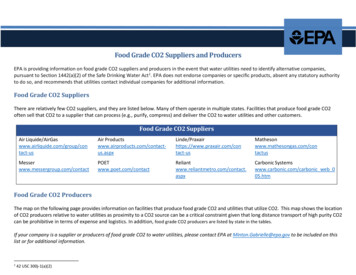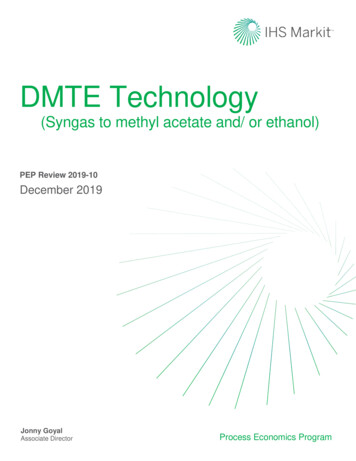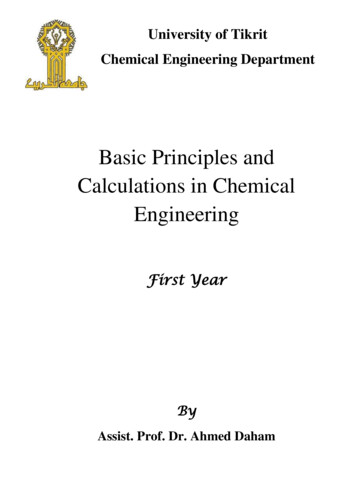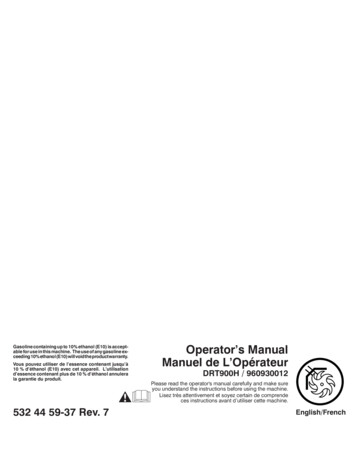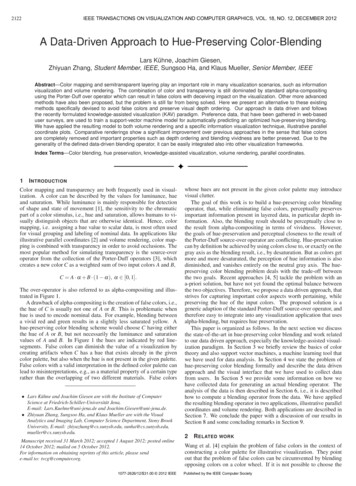
Transcription
RU-45-02-65-270222/FACTSHEETBudget Series #9ENCOURAGING ETHANOL BLENDINGUnion Budget 2022-23 gives further boost to blending through tax on unblended fuel(Ministry of Petroleum & Natural Gas)February 27, 2022“Ethanol was rarely discussed in the country about 7-8 years ago. But now ethanol has becomeone of the major priorities of 21st century India. The focus on ethanol is having a better impacton the environment as well as on the lives of farmers.”- Prime Minister Narendra ModiUnion Budget 2022-23: Proposal to encourage ethanol-blended fuelIn India’s quest for a clean energy future and to keep up with its commitment to the SustainableDevelopment Goals (SDGs), the Government of India has been increasingly promoting the useof ethanol-blended fuel in the country. To further encourage the blending of fuel, the UnionBudget 2022-23 has announced an additional differential excise duty of Rupees Two perlitre on unblended fuel from the 1st day of October 2022.The decision comes as an attempt to prompt retailers, especially private oil companies, toswitch to ethanol-blended fuel across the country to achieve energy security and a transitioninto a thriving low carbon economy which is critical for a growing nation like India. This stepwill also help bring down India’s petroleum imports.What is Ethanol? Why is it necessary as an alternative fuel?The energy demand in our country is rising due to an expanding economy, growing population,increasing urbanization, evolving lifestyles and rising spending power. About 98 per cent ofthe fuel requirement in the road transportation sector is currently met by fossil fuels and theremaining 2 per cent by bio-fuels.
Ethanol is one of the principal bio-fuels, which is naturally produced by thefermentation of sugars by yeasts or via petrochemical processes such as ethylenehydration. It is used as a chemical solvent and in the synthesis of organic compounds,apart from being an alternative fuel source. Domestic bio-fuels provide a strategic opportunity to the country, as they reduce thenation’s dependence on imported fossil fuels. In addition, when utilized with appropriate care, bio-fuels can be environmentallyfriendly,sustainableenergy sources. They can also helpgenerate employment,promote Make in India,SwachhBharat,doubling of farmers’incomes and promoteWastetoWealthgeneration.Ethanol Blending Programme1The Ethanol Blended Petrol (EBP) Programme was launched in January 2003 with the sale of5% ethanol blended petrol in nine States and four UTs. In 2006, the Ministry of Petroleumand Natural Gas extended the sale of 5% Ethanol Blended Petrol to 20 states and four UTs ofthe country. However, the performance of the programme remained limited due to challengessuch as non-inclusion of conversion of grain to ethanol, high taxation of ethanol, limitedavailability of feedstock and infrastructure, among others.The Government under the leadership of Prime Minister Narendra Modi, in line with its Energysecurity, climate change and rural economy enhancement goals, has initiated multiprongedreforms to boost Ethanol usage in the country. Under the Ethanol Blended Petrol (EBP)Program, an indicative target of 20% blending of ethanol in petrol by 2030 was laid out.Subsequently, the target year for achieving 20% ethanol blending in petrol was alsoadvanced to 2025 by ‘The Cabinet Committee on Economic Affairs’ (CCEA) in 2020.Ethanol Blending Programme- Progress TimelineSince the inception of the Ethanol Blending Programme (EBP), there have been significantmeasures taken by the Central Government to increase the production and utilization BlendingInIndia compressed.pdf
ethanol which are mentioned in the give below.
Significant Outcomes2The results from these landmark reforms have had positive effects not only on the country’seconomy but also on the income of the farmers, and they are also geared up to recharge therural economy. Some of the significant outcomes from these reforms are: Ethanol supplies and blending percentage have increased more than five times inlast six years. While 38 crore litres of Ethanol was procured during the year 2013-14,in 2020-21 this jumped nearly eight times to 322 crore litres.Remunerative prices of ethanol to suppliers have more than doubled in last six years-amajor boost to farmers’ income. An eight-fold jump in procurement in last six yearsand the price of procurement going up by nearly 2.5 times, has led to a significantjump in the income of farmers.Ethanol distillation capacities have almost doubled and number of distilleries increased by40 per cent in five years.The decision to allow diversion of B heavy molasses, sugarcane juice / sugar / sugar syrup forethanol production in 2018-19 enabled reliable supply of feedstock and the price stabilityof cificdocs/documents/2021/oct/doc202110441.pdf
Under EBP, OMCs (Oil Marketing Companies) have paid sugar mills nearly Rs. 42,000 crorefor ethanol supplies in the last seven years, which has helped mills to clear farmers’ dues.Additionally, decision has been taken to buy damaged and surplus food grains for ethanolproduction, ensuring price value for surplus grain stock as well as accommodating the freshseason crop to meet EBP target.The cumulative foreign exchange impact due to EBP Programme is estimated over Rs. 26,509crores during the period ESY 2014 to 2021 (up to July 2021).One crore litre of ethanol-blended petrol can save around 20000 tons of carbon dioxideemission.Greenhousegasemissions due to the EBPProgramme were lowered by192 lakh tons from 2014 to 2021(up to July 2021).The IDR Act implementationenabled the state governments toavoid complicated documentationprocedures and conduct probusiness activities like-approvals,online permits, electronic locking,GPS tracking of vehicles carryingethanol etc.Roadmap for Ethanol Blending in India 2020-25On the occasion of World Environment Day 2021, Prime Minister Narendra Modi released the“Report of the Expert Committee on Roadmap for Ethanol Blending in India 2020-2025”. Thereport suggested: (i) an annual roadmap for production and supply of ethanol till 2025-26, and(ii) systems for countrywide marketing of ethanol.
Key observations and recommendations from the Report:3 Fuel ethanol demand projection: India’s requirement of ethanol for petrol blendingwill increase from 173 crore litres in 2019-20 to 1,016 crore litres in 2025-26. Toenable roll out of ethanol production across India, ethanol may be supplied from surplusto deficit states based on the requirements to ensure uniform availability of ethanolblends in the country. Ethanol blending roadmap: The Report recommends the Ministry of Petroleum andNatural Gas to notify a plan for availability of E10 fuel (blend of 10% ethanol and90% petrol) by April 2022. Further, the Ministry is to notify a plan for the continuedavailability of the fuel for older vehicles. Fuel blended with 20% ethanol (E20) shouldbe launched in a phased manner from April 2023 to ensure the availability of E20 by2025. The rollout of higher ethanol blends may be done in phased manner, startingwith the states with surplus production of ethanol. Expediting regulatory clearances: The report recommends measures to expediteregulatory clearances for ethanol production such as expediting the issuing of consentto establish distilleries by state governments. Further, a single window system may beformulated by the Department for Promotion of Industry and Internal Trade to facilitatespeedy clearances for new projects and expansion of current projects for ethanolproduction. Environmental Impact: One litre of ethanol from sugar requires about 2,860 litres ofwater. In view of the need for water conservation, the report recommended that suitableincentives should be used to (i) source ethanol from less water-intensive crops, and (ii)promote production from maize and second-generation sources. Ethanol compatible vehicles: The Committee highlights that in order to use higherethanol blends, vehicles need to be designed holistically to prevent engine failure andlow fuel economy. To ensure production of ethanol-blended petrol compatible vehiclesin the future, the Committee recommended that: (i) E20 material compliant and E10tuned engine vehicles may be rolled out across the country from April 2023, and (ii)vehicles with E20 tuned engines can be rolled out from April 2025. Unrestricted movement of denatured ethanol: The report noted that ethanol used forblending purposes is denatured ethanol (unfit for human consumption). It further notedthat state governments are empowered to legislate, control, and levy taxes and dutieson liquor meant for human consumption. The report recommended that movement ofdenatured ethanol across India should not be under the control of states, but maybecontrolled only by the central government to ensure unrestricted movement /files/2021-06/EthanolBlendingInIndia compressed.pdf
iles/2021-06/EthanolBlendingInIndia -06/EthanolBlendingInIndia age.aspx?PRID px?PRID ID 1782275Further s/AR G/HP/RC/KM
ENCOURAGING ETHANOL BLENDING Union Budget 2022-23 gives further boost to blending through tax on unblended fuel (Ministry of Petroleum & Natural Gas) February 27, 2022 "Ethanol was rarely discussed in the country about 7-8 years ago. But now ethanol has become one of the major priorities of 21st century India. The focus on ethanol is having a .
